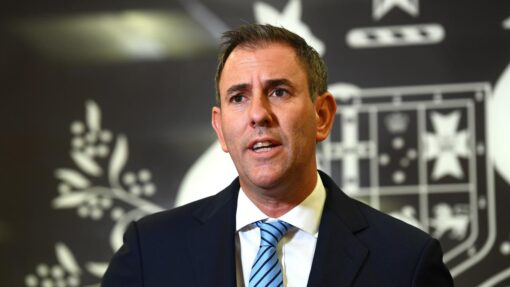Economy stuck in slow lane as households tighten belts
Poppy Johnston |

Cash-strapped households are cutting back on non-essential items to pay for basics, weighing on economic growth.
A paltry 0.2 per cent growth over the three months to June was supported by firm government spending, including on health.
Through-the-year growth was one per cent, the Australian Bureau of Statistics reported on Wednesday.

Head of national accounts at the bureau, Katherine Keenan, said annual financial-year economic growth was the lowest it had been since the recovery from the 1991 recession, excluding the pandemic.
Sluggish growth was anticipated as interest rates have been kept high to take the sting out of elevated inflation, with the latest numbers landing broadly in line with analyst expectations.
Treasurer Jim Chalmers said the main takeaway from the national accounts was a 0.2 per cent fall in household consumption, with people pulling back on discretionary items to afford essentials.
Combined with the lowest annual household savings ratio in 17 years, Dr Chalmers said households were clearly under pressure.
“It justifies our economic plan which is all about fighting inflation without smashing an economy which is already weak, and helping people doing it tough,” he said on Wednesday.

The opposition accused Labor of spending too much and called for austerity to contain inflation.
The shadow treasurer said Dr Chalmers was “fighting the laws of economics” rather than persistent price pressures.
“The government is hitting the accelerator at the same time as the Reserve Bank is hitting the brake, and that is how you wreck the engine,” Angus Taylor said.
A 1.4 per cent rise in government spending showed up in the latest figures.
Health services contributed to the increase, which Dr Chalmers said included “unavoidable” spending on everyday services Medicare and the NDIS.
Higher wage bills at state and council level also contributed to the increase.
The RBA was bracing for another weak set of growth data and Betashares chief economist David Bassanese said the result was broadly in line with its expectations.
“It’s just what the RBA still feels is required to ensure inflation continues to trend lower this year – in which case, the RBA could ease it’s foot of the brake with a rate cut early next year,” Mr Bassanese said.
The fall in private consumer spending was in part a correction to a Taylor Swift-inspired boost in spending during her tour earlier this year.
“All up, today’s GDP results, although soft, are not weak enough to bring forward the timing of possible RBA rate cuts – as it was in line with RBA expectations and is exactly what it still thinks is necessary to bring inflation down.”

Deloitte Access Economics partner Stephen Smith warned Australia’s per capita recession had deepened, with growth in decline for the sixth quarter in a row when accounting for population growth.
The June quarter release ran counter to the RBA’s concerns about “homegrown” inflation fuelled by resilient demand, Mr Smith said.
The central bank maintains underlying price pressures are still strong and has kept its options open on its next interest rate moves, while pushing back on expectation of near-term cuts.
Mr Smith warned another rate rise would cruel the economy, urging the central bank and governments to pivot from containing inflation to stimulating growth.
AAP


